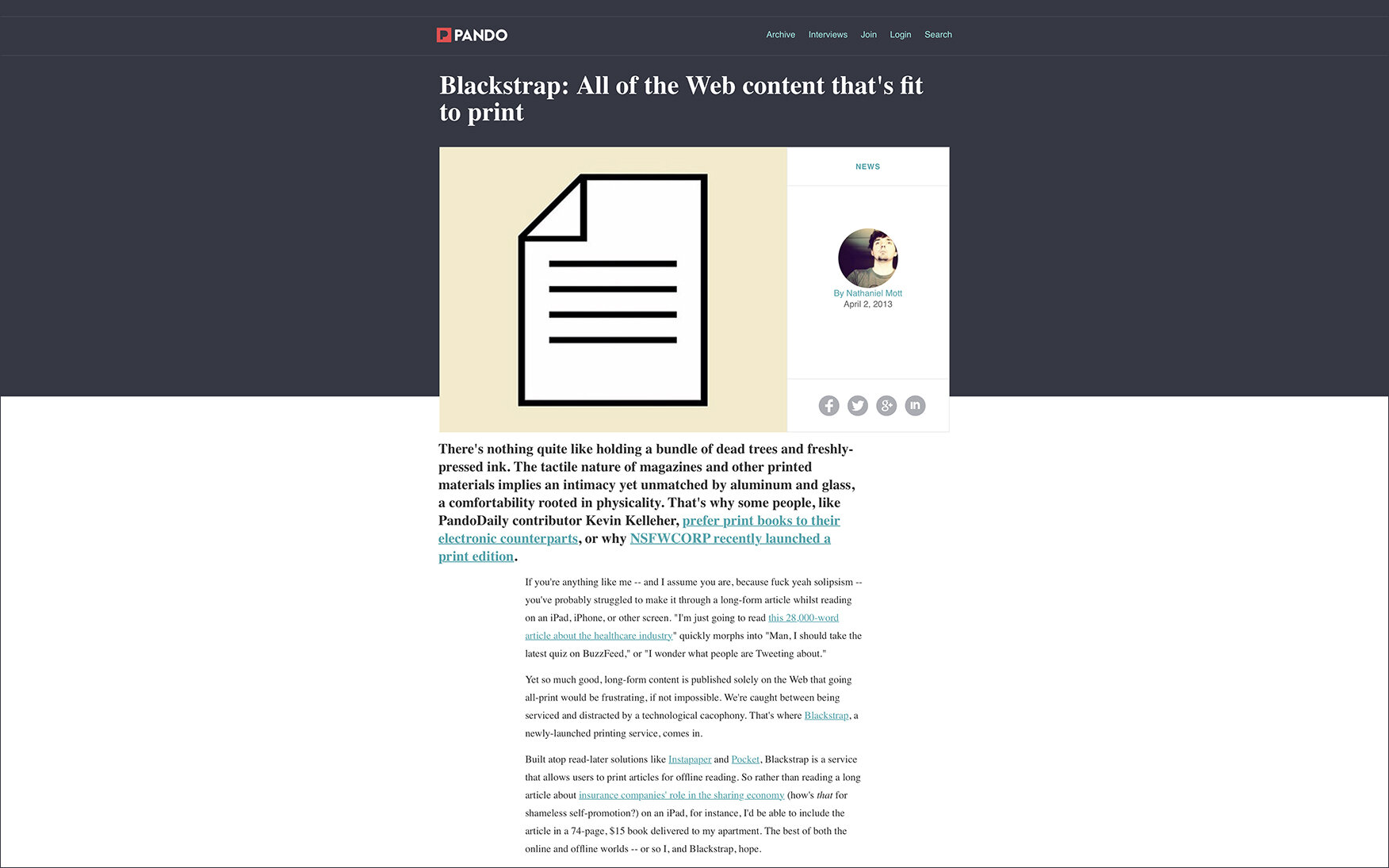Pando Daily
Role: Illustrator
Pando Daily is a web publication offering technology news, analysis and commentary, focusing mainly on Silicon Valley and startup companies. It was started by former TechCrunch writer Sarah Lacy in January 2012. At the time, Business Insider called it TechCrunch 2.0. It billed itself at launch as "the site of record for Silicon Valley”. It’s company mission stated; “We have one goal here at Pando Daily: To be the site of record for that startup root-system and everything that springs up from it, cycle-after-cycle. That sounds simple but it’ll be incredibly hard to pull off. It’s not something we accomplish on day one or even day 300. It’s something we accomplish by waking up every single day and writing the best stuff we can, and continually adding like-minded staffers who have the passion, drive and talent to do the same.”
The name Pando Daily was inspired by a tree colony in Utah, whose massive root system covers 106 acres and is continually sprouting new stems or trunks, even after wildfires have destroyed existing trunks. Sarah Lacy wrote, "It’s the perfect metaphor for what I love about Silicon Valley. It’s not just individual hot startups of-the-moment; it’s that unique startup ecosystem that continually shoots up new companies no matter how frothy or scorched everything above ground gets." At launch, Pando Daily had a number of staff writers and guest contributors including Michael Arrington, Paul Carr, M.G. Siegler, and Farhad Manjoo.
Below are some of the Pando Daily articles that my work appeared in.
There's a tension between the flashy, venture-backed sharing economy companies gracing the cover of glossy magazines, and the pure-of-heart collaborative consumption community -- the original sharers, barterers, car-poolers, and couch surfers that feel the term has, of late, been co-opted and perverted with money-hungry capitalism.
One company that's mostly stayed out of that debate is LiquidSpace. The company may have done that by not trying to align itself with every list, feature, and press mention related to the collaborative consumption. Or it may have done that by co-opting the idea in an even more radical way. Liquidspace takes sharing economy the ideal of recycling unused resources, and sells it to corporations. There will be no accusations of selling out, because LiquidSpace's goal from the very start has been to sell.
The company's desk rental platform has now begun enterprise-level pilot programs with a small group of large Fortune 500 companies, most notably Accenture. The integration allows their employees to work wherever they choose (within LiquidSpace's growing network of 750 venues), particularly when they're traveling. The idea is that when employees are given a choice as to where they might be able to work or take meetings, they feel empowered and engaged. It may cut down on real estate costs for the parent company, too.
Beyond that, companies are beginning to implement Liquidspace's tools internally as a way to book meeting rooms and dole out empty desks to traveling employees. I can attest that the conference room booking software used by any large company I've worked for has been clunky, unreliable and confusing; LiquidSpace's software (or really anything built in the last 15 years) has to be an upgrade.
In this way, LiquidSpace is using the OpenTable model for available workspaces. First OpenTable got the restaurants to use its software internally as a way to manage their seating system. Then they began taking reservations on the platform. LiquidSpace believes that, as more companies implement their enterprise offering, they'll also see the value of employees booking rooms and desks outside of the platform when they're traveling or taking meetings.
But no one accused OpenTable of participating in the sharing economy. I posed the same question to Mark Gilbreath, CEO of LiquidSpace.
"We're bringing sharing economy concepts to the enterprise," he says. One can quibble over the definition of the sharing economy (and oh have we), but Gilbreath defines it as "driving utilization of assets and bringing the purchasing decision down to an individual." Liquidspace takes existing inventory and resources and puts it to use, just like RelayRides, Airbnb or TaskRabbit. Only, within corporations. (Individuals use LiquidSpace's desk rental, too.)
On the flip side, the most well-known of LiquidSpace's competitors, LooseCubes, was closely aligned with the idea of the sharing economy. Last November the site closed its doors suddenly, despite having raised $7.8 million just five months prior. The service was popular and had quickly expanded globally, but most blame the company's business model, which did not which did not charge users to reserve desk space, for its demise. LooseCubes' management disagreed with investors over its future and much of that $7.8 million never actually made it to the company.
LiquidSpace -- also venture-backed -- has earned early revenue by, well, charging users. Gilbreath will argue his company never competed with LooseCubes, but the models are too similar to ignore a comparison. Others, including Neardesk, Sharedesk, Desktime and PivotDesk, compete with their own twists on desk-sharing. With LiquidSpace's approach of targeting employees of large corporations (as opposed to the cash-strapped freelancers and creative types targeted by LooseCubes), it has found a market willing to pay for its office space inventory. This month the expects 25,000 bookings on its site, the majority of which are external, public bookings (which cost money).
In that way, it's less "sharing economy" in the most literal sense of the word, and much more "inventory re-allocation." For everyone, corporations included.
Link to article is here.
There's nothing quite like holding a bundle of dead trees and freshly-pressed ink. The tactile nature of magazines and other printed materials implies an intimacy yet unmatched by aluminum and glass, a comfortability rooted in physicality. That's why some people, like Pando Daily contributor Kevin Kelleher, prefer print books to their electronic counterparts, or why NSFWCORP recently launched a print edition.
If you're anything like me -- and I assume you are, because fuck yeah solipsism -- you've probably struggled to make it through a long-form article whilst reading on an iPad, iPhone, or other screen. "I'm just going to read this 28,000-word article about the healthcare industry" quickly morphs into "Man, I should take the latest quiz on BuzzFeed," or "I wonder what people are Tweeting about."
Yet so much good, long-form content is published solely on the Web that going all-print would be frustrating, if not impossible. We're caught between being serviced and distracted by a technological cacophony. That's where Blackstrap, a newly-launched printing service, comes in.
Built atop read-later solutions like Instapaper and Pocket, Blackstrap is a service that allows users to print articles for offline reading. So rather than reading a long article about insurance companies' role in the sharing economy (how's that for shameless self-promotion?) on an iPad, for instance, I'd be able to include the article in a 74-page, $15 book delivered to my apartment. The best of both the online and offline worlds -- or so I, and Blackstrap, hope.
"The reality is that digital is awesome for so many things," says Blackstrap co-creator Tyler Fonda, "But when it comes to absorbing information it's just extraordinarily distracting."
Fonda, along with Elliott Blatt and Irwin Chen, initially launched Blackstrap as a side project they could use to de-digitize their lives. It was meant to be a small tool for friends and family, but after bloggers like MG Siegler (an investor in Pando Daily, by way of CrunchFund) took note of the concept, Fonda says that the group decided to expand their vision.
"We had to rearchitect our approach to this launch," Fonda says. "When the original book went up, we had generated a PDF from our Instapaper queue and fired it off to our printing partner and we got a book back. That was the extent of it." So the team decided to build a front-end for Blackstrap that would allow users to decide which articles should appear in their book, developing the service over the course of a few months while continuing their day jobs.
Now Blackstrap is finally ready for an initial launch. I went through the signup process myself yesterday, connecting my Pocket account and choosing a smattering of articles from Pando Daily, The Verge, and other outlets for my first book, and found the experience pleasant enough. It isn't complicated in the leas. If you know how to add something to Instapaper or Pocket, you'll likely be able to figure out how to add that same article to your Blackstrap book.
Perhaps the greatest barrier between potential and actualized customers is the $15 starting price. That's a lot to lay down for an unproven product, especially when all of the content has already been gathered from publishers for free. Fonda says that the price is what allows Blackstrap to build a quality book, and that Blackstrap will continue to experiment with different prices and products after the team is able to garner feedback from early adopters.
My book is currently on its way to the printer, and I'm hoping that it will arrive at my apartment fairly soon. It's about damned time I was able to finish a few of these long-form pieces gathering dust in my Pocket queue, and if Blackstrap even half-delivers on its promise, my book should help make that happen. Finally.
There's a lot of great stuff to read on the Web. Now there's finally a way to get that content without having to weather the constant downpour of distractions of the Web itself.
Link to article is here.
© 2025 Pando Daily







